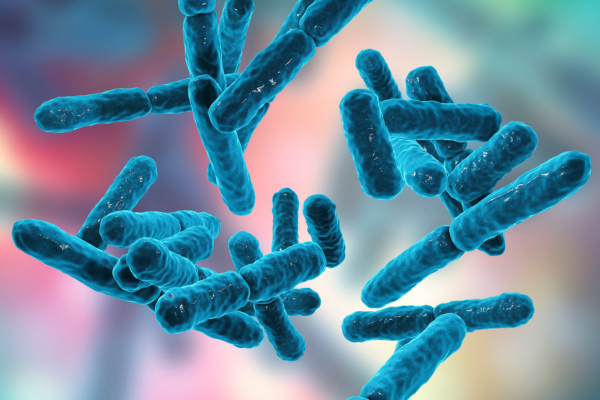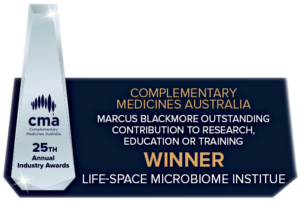Thanks to the explosion of microbiome research, the landscape for microbiome modulating therapies has significantly expanded in recent years. According to the International Scientific Association of Probiotics and Prebiotics (ISAPP), ‘biotic’ is a broad term used to encompass all microbiome modulating medicines, including probiotics, prebiotics, synbiotics, and postbiotics.(1)
Health practitioners should note that each biotic therapy has unique characteristics and therefore mechanisms of action and therapeutic applications.

Biotic therapy definitions:
Prebiotics
A prebiotic is defined as a “substrate that is selectively utilised by host microorganisms conferring a health benefit.” Prebiotics typically consist of non-digestible carbohydrates and dietary nutrients, such as polyphenols, which can serve as a ‘food’ for the beneficial microorganisms that reside within the gastrointestinal tract. The most well-recognized types of prebiotics include fructo-oligosaccharides (FOS), galacto-oligosaccharides (GOS), inulin, and human milk oligosaccharides (HMOs) that can be found in varied sources such as food, breast milk and supplements.(2) Prebiotics act by modulating the microbiome, with different prebiotics forming substrates for different strains and species of microbes. Fermentation of prebiotics by microbes can result in the production of beneficial metabolites, enzymes and nutrients which can regulate the intestinal environment and contribute to a variety of health benefits including immune and metabolic regulation.(3,4)
Probiotics
Probiotics are defined as “live micro-organisms that, when administered in adequate amounts, confer a health benefit on the host. Probiotic therapies typically consist of live bacteria or yeasts, belonging to the genera Bifidobacterium, Lactobacillus and Saccharomyces.(5) Probiotics have been shown to exert their benefits via the following actions:
- Digestion of foods
- Synthesis of nutrients and metabolites
- Pathogen control
- Adipose storage efficiency
- Immune development, modulation, and maturation
- Maintenance of the gut barrier integrity.(6,7)
Synbiotics
Synbiotics are defined as “a mixture comprising live microorganisms and substrate(s) selectively utilised by host micro-organisms that confers a health benefit on the host”. (8) A symbiotic comes in the form of a therapeutic supplement and can be comprised as a combination of a pre- and probiotic that meet the following criteria:
- The pre- and probiotic work independently to achieve one or more health benefits.
- The pre- and probiotic work synergistically to achieve one or more health benefits.
To meet the criteria of a synbiotics, a study must demonstrate a health benefit, whilst also showing selective utilisation of the substrate by the co-administered live microorganism
Postbiotics
Postbiotics are defined as “a preparation of inanimate microorganisms and/or their components that confers a health benefit to the host”.(9) Unlike probiotics, postbiotics do not require living cells to induce health benefits. Postbiotics may contain intact inanimate microbial cells, and/or microbial cell fragments/structures with or without metabolites/end products such as vitamins, metabolites or enzymes.(7) Research has shown postbiotics can confer immunomodulating health benefits.(9)
Considerations for the healthcare practitioner
Selecting the appropriate biotic therapy can be influenced by multiple factors including disease state, age, gender as well as dosing, format, and economical considerations for the patient. For instance, many prebiotics fall under the umbrella term of fermentable oligosaccharides, disaccharides, monosaccharides, and polyols (FODMAPs) which can lead to aggravation of existing conditions such as irritable bowel syndrome (IBS). Healthcare practitioners should be guided by available evidence when choosing their preferred biotic therapy and dosing strategy.(10)
Furthermore, while certain biotics can also be found naturally occurring in certain foods, or added to functional foods, it is important to note that food products do not undergo the same rigorous processes for labelling and listing as are applied to TGA listed probiotic supplements and may therefore differ in therapeutic applications and outcomes.
References
- International Scientific Association for Probiotics and Prebiotics (ISAPP) [Internet]. 2019 [cited 2023 Jul 17]. Defining emerging ‘biotics’. Available from: https://isappscience.org/defining-emerging-biotics/
- International Scientific Association for Probiotics and Prebiotics (ISAPP) [Internet]. [cited 2023 Jul 14]. Prebiotics. Available from: https://isappscience.org/for-consumers/learn/prebiotics/
- Nazzaro F, Fratianni F, De Feo V, Battistelli A, Da Cruz AG, Coppola R. Chapter Two – Polyphenols, the new frontiers of prebiotics. In: da Cruz AG, Prudencio ES, Esmerino EA, da Silva MC, editors. Advances in Food and Nutrition Research [Internet]. Academic Press; 2020 [cited 2023 Jun 21]. p. 35–89. (Probiotic and Prebiotics in Foods: Challenges, Innovations and Advances; vol. 94). Available from: https://www.sciencedirect.com/science/article/pii/S1043452620300322
- Davani-Davari D, Negahdaripour M, Karimzadeh I, Seifan M, Mohkam M, Masoumi SJ, et al. Prebiotics: Definition, Types, Sources, Mechanisms, and Clinical Applications. Foods. 2019 Mar 9;8(3):92.
- International Scientific Association for Probiotics and Prebiotics (ISAPP) [Internet]. [cited 2023 Jun 21]. Probiotics. Available from: https://isappscience.org/for-clinicians/resources/probiotics/
- Rowland I, Gibson G, Heinken A, Scott K, Swann J, Thiele I, et al. Gut microbiota functions: metabolism of nutrients and other food components. Eur J Nutr. 2018 Feb;57(1):1–24.
- Scott E, De Paepe K, Van de Wiele T. Postbiotics and Their Health Modulatory Biomolecules. Biomolecules. 2022 Nov;12(11):1640.
- International Scientific Association for Probiotics and Prebiotics (ISAPP) [Internet]. [cited 2023 Jul 14]. Synbiotics infographic. Available from: https://isappscience.org/synbiotics-infographic/
- KC. International Scientific Association for Probiotics and Prebiotics (ISAPP). 2021 [cited 2023 Jul 14]. Behind the publication: Understanding ISAPP’s new scientific consensus definition of postbiotics. Available from: https://isappscience.org/behind-the-publication-understanding-isapps-new-scientific-consensus-definition-of-postbiotics/
- About FODMAPs and IBS | Monash FODMAP – Monash Fodmap [Internet]. [cited 2023 Jul 14]. Available from: http://www.monashfodmap.com/about-fodmap-and-ibs/

